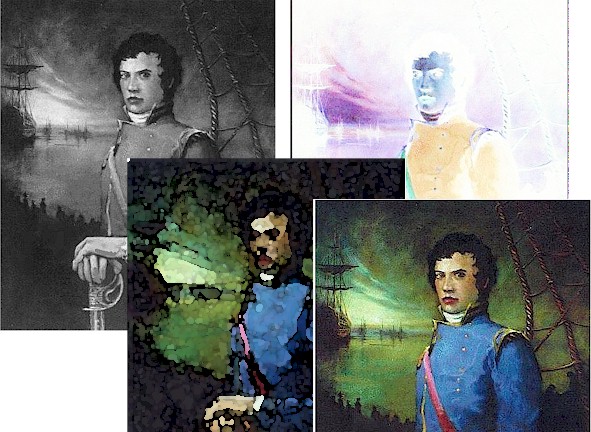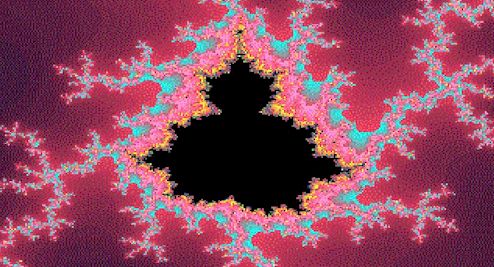Relationships
We don't just paint 'things' we construct visusl relationships. Now approach a topic of which, in art (relationships) I have some knowledge. Obviously in life it is otherwise - single and thrice divorced.
Back to safer ground and painting; every element in a painting can only be considered in its relationship with the other parts. Below in my portrait of Fletcher Christian the parts that draw the eye are usually the areas of maximum contrast.

This portrait has three competing areas of contrast, the forehead the background and the hands. They create a triangle and their relationship is crucial. I am still unsure as to whether the distant light is too bright in relation to the other highlights. Should I dim it and draw the eye more to Christian's face? These are judgements of relationships. Above I have used three computer devices to analyse the design.
.
.. AND USING CHAOS
I view it like this:
Let us imagine our life as a room and the room has a partition. On one side of the partition is a continually moving, changing world of disorder and chaos. It is populated by all the creatures of the imagination - and more than a few not invited. It is a world of the surreal, of dreams and nightmares, of anti-logic and senselessness. On the other side of our partition we have order, logic and regular forms. The world of the pyramids, spheres and cubes - the world of habit, pattern and order.
Some people are not comfortable until the partition is forced almost completely to one end of the room (90% order 10% chaos) while others can live in a 50/50 situation. Some will rejoice in the high chaos while others believe it is a factor of age, gender, right and left brain, or potty-training. Some even go so far as to refer to it as the Jeckle and Hyde, Don Quixote or madness syndrome.
I believe we must live with both sides of our existence and recognize the importance of each. We need chaos to think laterally, to be inventive, to associate disparate ideas and concepts. That is the life blood of the creative idea. This is not to underestimate the value of pattern, order and habit. They are the very tools that allow meaning to be drawn from disorder - the foundation blocks of moral and civilized thought and the flame that draws the fluttering moth.

You will note how, up till now, my lessons have dwelt in the rules and order side of the room in an attempt to understand the chaos all about us. For some this may have moved the partition a little to the side of order. Never mind! Just think of what you have learnt so far as your small toolbox with which you can use to disassemble, reassemble and to analyse whatever your imagination demands. And remember, chaos need not be feared, used properly it can be used to pick the problem lock.
Experiments in color, design, form and texture are the basis of most of the art movements in the last 150 years. Whether they were abstract expressionism, impressionism, surrealism or post-modernism they are all attempts at dissembling and re-assembling, of moving into chaos to hopefully discover some new meaning. We should all similarly experiment especially when we find order stifling creativity ... or the present art administration becoming institutionalized and self-absorbed.
A study of fractals is useful when allowing the mind passage between order and chaos.
|